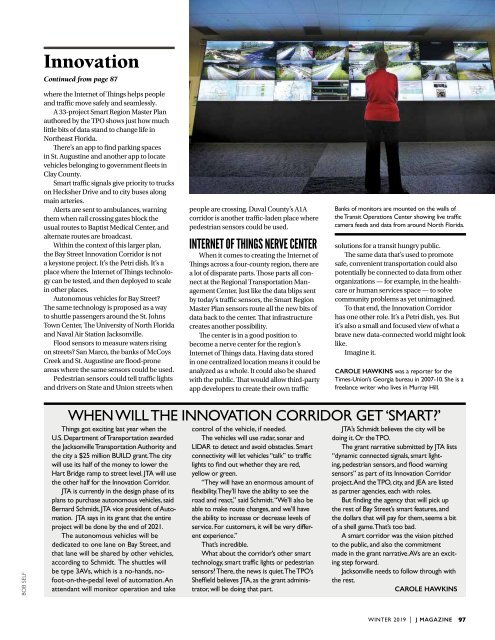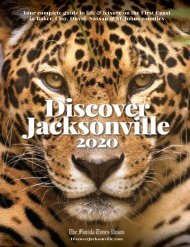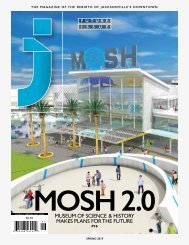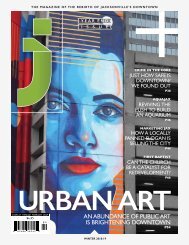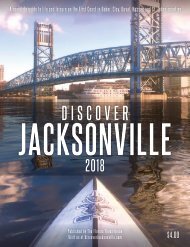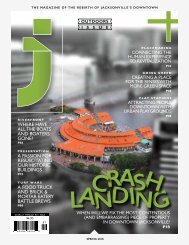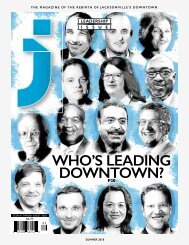J Magazine Winter 2019
You also want an ePaper? Increase the reach of your titles
YUMPU automatically turns print PDFs into web optimized ePapers that Google loves.
Innovation<br />
Continued from page 87<br />
where the Internet of Things helps people<br />
and traffic move safely and seamlessly.<br />
A 33-project Smart Region Master Plan<br />
authored by the TPO shows just how much<br />
little bits of data stand to change life in<br />
Northeast Florida.<br />
There’s an app to find parking spaces<br />
in St. Augustine and another app to locate<br />
vehicles belonging to government fleets in<br />
Clay County.<br />
Smart traffic signals give priority to trucks<br />
on Hecksher Drive and to city buses along<br />
main arteries.<br />
Alerts are sent to ambulances, warning<br />
them when rail crossing gates block the<br />
usual routes to Baptist Medical Center, and<br />
alternate routes are broadcast.<br />
Within the context of this larger plan,<br />
the Bay Street Innovation Corridor is not<br />
a keystone project. It’s the Petri dish. It’s a<br />
place where the Internet of Things technology<br />
can be tested, and then deployed to scale<br />
in other places.<br />
Autonomous vehicles for Bay Street?<br />
The same technology is proposed as a way<br />
to shuttle passengers around the St. Johns<br />
Town Center, The University of North Florida<br />
and Naval Air Station Jacksonville.<br />
Flood sensors to measure waters rising<br />
on streets? San Marco, the banks of McCoys<br />
Creek and St. Augustine are flood-prone<br />
areas where the same sensors could be used.<br />
Pedestrian sensors could tell traffic lights<br />
and drivers on State and Union streets when<br />
people are crossing. Duval County’s A1A<br />
corridor is another traffic-laden place where<br />
pedestrian sensors could be used.<br />
Internet of Things NERVE CENTER<br />
When it comes to creating the Internet of<br />
Things across a four-county region, there are<br />
a lot of disparate parts. Those parts all connect<br />
at the Regional Transportation Management<br />
Center. Just like the data blips sent<br />
by today’s traffic sensors, the Smart Region<br />
Master Plan sensors route all the new bits of<br />
data back to the center. That infrastructure<br />
creates another possibility.<br />
The center is in a good position to<br />
become a nerve center for the region’s<br />
Internet of Things data. Having data stored<br />
in one centralized location means it could be<br />
analyzed as a whole. It could also be shared<br />
with the public. That would allow third-party<br />
app developers to create their own traffic<br />
Banks of monitors are mounted on the walls of<br />
the Transit Operations Center showing live traffic<br />
camera feeds and data from around North Florida.<br />
solutions for a transit hungry public.<br />
The same data that’s used to promote<br />
safe, convenient transportation could also<br />
potentially be connected to data from other<br />
organizations — for example, in the healthcare<br />
or human services space — to solve<br />
community problems as yet unimagined.<br />
To that end, the Innovation Corridor<br />
has one other role. It’s a Petri dish, yes. But<br />
it’s also a small and focused view of what a<br />
brave new data-connected world might look<br />
like.<br />
Imagine it.<br />
CAROLE HAWKINS was a reporter for the<br />
Times-Union’s Georgia bureau in 2007-10. She is a<br />
freelance writer who lives in Murray Hill.<br />
BOB SELF<br />
When will the Innovation Corridor get ‘smart?’<br />
Things got exciting last year when the<br />
U.S. Department of Transportation awarded<br />
the Jacksonville Transportation Authority and<br />
the city a $25 million BUILD grant. The city<br />
will use its half of the money to lower the<br />
Hart Bridge ramp to street level. JTA will use<br />
the other half for the Innovation Corridor.<br />
JTA is currently in the design phase of its<br />
plans to purchase autonomous vehicles, said<br />
Bernard Schmidt, JTA vice president of Automation.<br />
JTA says in its grant that the entire<br />
project will be done by the end of 2021.<br />
The autonomous vehicles will be<br />
dedicated to one lane on Bay Street, and<br />
that lane will be shared by other vehicles,<br />
according to Schmidt. The shuttles will<br />
be type 3AVs, which is a no-hands, nofoot-on-the-pedal<br />
level of automation. An<br />
attendant will monitor operation and take<br />
control of the vehicle, if needed.<br />
The vehicles will use radar, sonar and<br />
LIDAR to detect and avoid obstacles. Smart<br />
connectivity will let vehicles “talk” to traffic<br />
lights to find out whether they are red,<br />
yellow or green.<br />
“They will have an enormous amount of<br />
flexibility. They’ll have the ability to see the<br />
road and react,” said Schmidt. “We’ll also be<br />
able to make route changes, and we’ll have<br />
the ability to increase or decrease levels of<br />
service. For customers, it will be very different<br />
experience.”<br />
That’s incredible.<br />
What about the corridor’s other smart<br />
technology, smart traffic lights or pedestrian<br />
sensors? There, the news is quiet. The TPO’s<br />
Sheffield believes JTA, as the grant administrator,<br />
will be doing that part.<br />
JTA’s Schmidt believes the city will be<br />
doing it. Or the TPO.<br />
The grant narrative submitted by JTA lists<br />
“dynamic connected signals, smart lighting,<br />
pedestrian sensors, and flood warning<br />
sensors” as part of its Innovation Corridor<br />
project. And the TPO, city, and JEA are listed<br />
as partner agencies, each with roles.<br />
But finding the agency that will pick up<br />
the rest of Bay Street’s smart features, and<br />
the dollars that will pay for them, seems a bit<br />
of a shell game. That’s too bad.<br />
A smart corridor was the vision pitched<br />
to the public, and also the commitment<br />
made in the grant narrative. AVs are an exciting<br />
step forward.<br />
Jacksonville needs to follow through with<br />
the rest.<br />
CAROLE HAWKINS<br />
WINTER <strong>2019</strong> | J MAGAZINE 97


